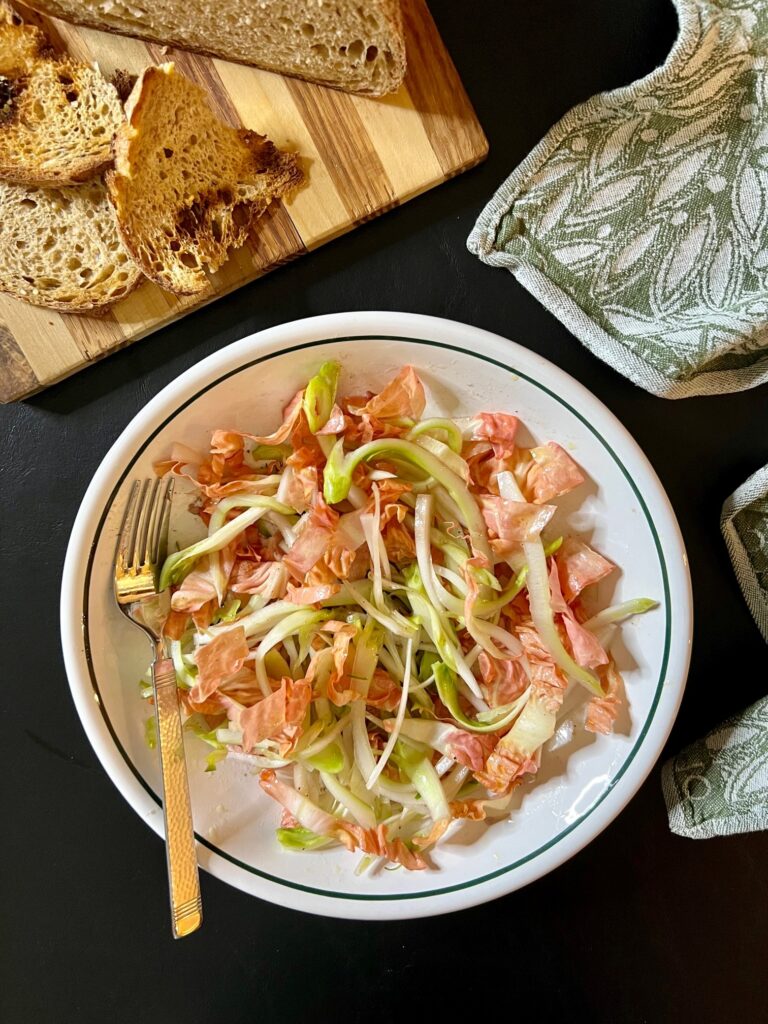
Photo by Lorelle Del Matto
Puntarelle and Radicchio Rosa del Veneto Salad
Americans are more positive about defining “healthy food” according to 2021 research by the International Food and Information Council (1) which showed that 27% of Americans say “healthy food” means the presence of components such as fruits, veggies, and nutrients (compared to 17% in 2016).
People are on point, but beliefs and practices don’t always align. Nearly 90% of Americans don’t meet recommendations for fruit and vegetables (2,3).
You don’t need much to reap positive benefits. The recommendation to eat “5-a-day” of fruits and vegetables was recently validated in research that pooled data from dozens of studies including self-reported information from some 2 million people followed for up to 30 years (4,5).
Compared to participants who consumed 2 servings per day of vegetables and fruits, those consuming 5 daily had a 13% reduced risk of all-cause mortality. Eating a combination of 2 servings of fruit and 3 servings of vegetables showed the lowest risks of cancer, cardiovascular disease, and respiratory disease mortality.
The power of produce likely comes from the bio-active substances in vegetables and fruits that may have synergistic or additive benefits– thousands of polyphenols with antioxidant and other properties such as flavonoids and phenolic acids, beta carotene, minerals such as potassium and magnesium, vitamin C, and dietary fiber.
What’s a serving? This study noted serving sizes as ½ cup cooked vegetable (1 cup of a raw leafy vegetable), or 1 piece of fruit like an apple or orange, or ¼ cup dried fruit (5), smaller than recommendations in Dietary Guidelines for Americans 2020-2025 (3).
In this study, “including green leafy vegetables, nonstarchy vegetables, cruciferous vegetables, citrus fruit, vitamin C–rich and β-carotene–rich fruit and vegetables, were inversely associated with total mortality (4).” Benefits were not seen with fruit juices and starchy vegetables such as peas, corn, and potatoes. I don’t ban these from my diet, but I do aim for variety and prioritize the abovementioned heavy hitters, whole fruits and veggies over juice and keep “loaded” and fried potatoes to occasional treats.
Need a nudge to eat more produce? Include a veg or fruit at every meal and snack and use them in recipes. Are you bored with a routine of eating the same few fruits and veggies? Try one new vegetable or fruit each week. Or cook your old faves in a new way.
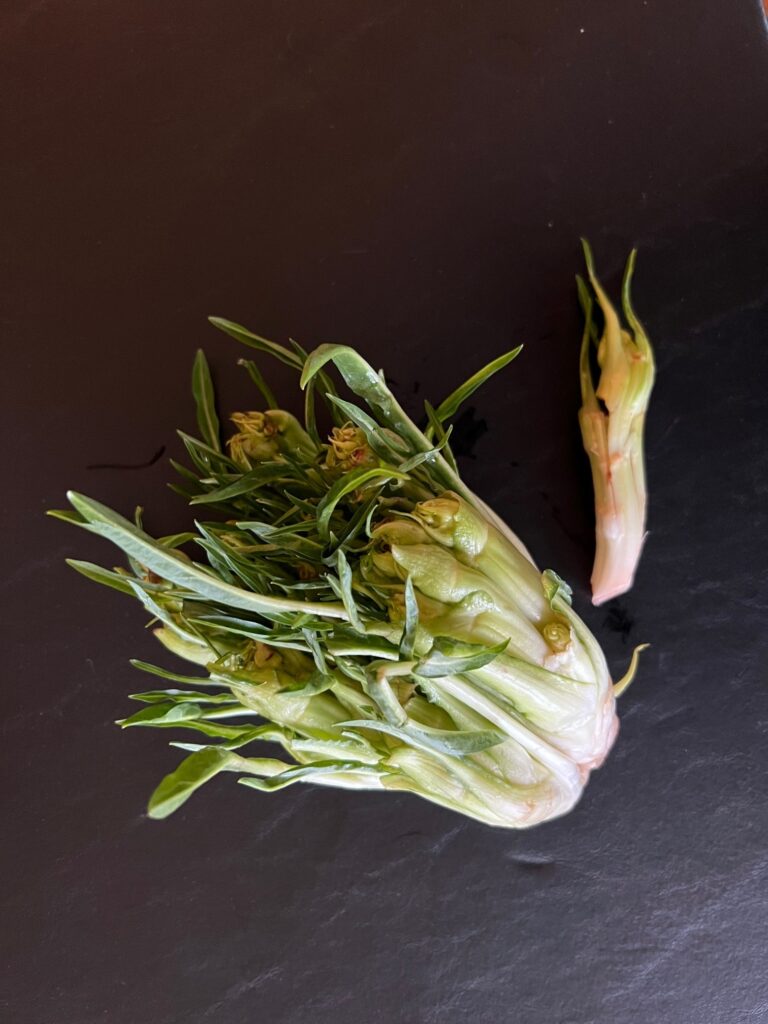
Recently I was thrilled to find new-to-me vegetables at my local Metropolitan Market.I I took home a puntarella, prized by many Italian-leaning chefs and the star of the well-known Roman dish Puntarelle alla Romana, and a less-common radicchio, the pink, football-shaped Rosa del Veneto.
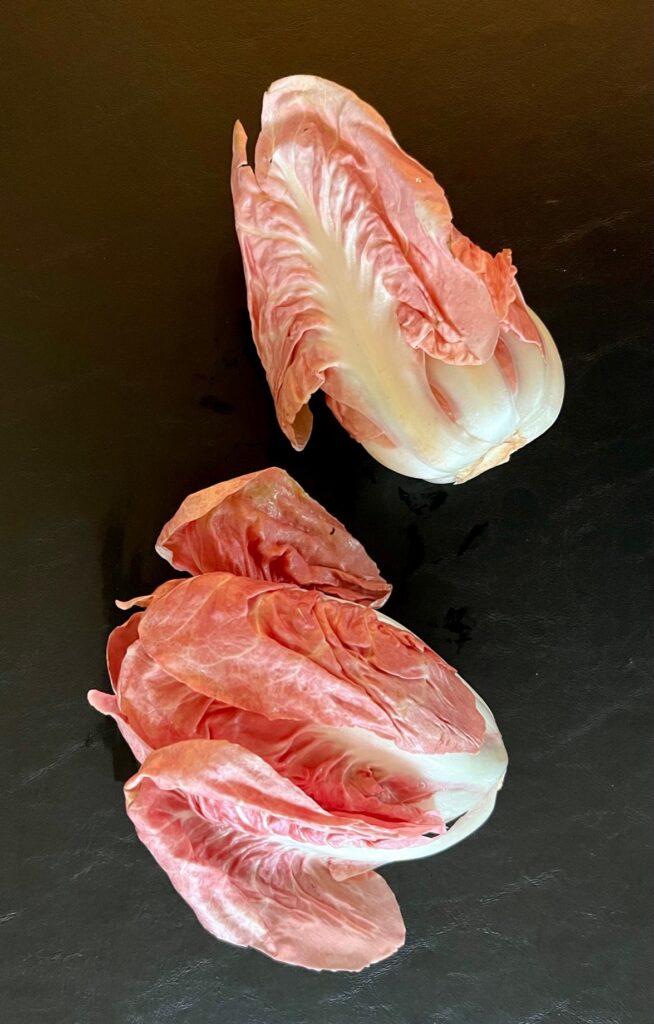
I’m not the only one enthusiastic about these chicory-family vegetables. They inspired the creation of Seattle’s annual Chicory Festival, the work of Pacific Northwest chicory farmers who teamed up with restaurants and other enthusiasts to support growers and educate others about these beautiful, bitter vegetables (6).
Inspired by Puntarelle alla Romana, I made a piquant dressing with olive oil, anchovy, garlic, and vinegar and tossed it with the sliced radicchio and strips of iced puntarelle stalks. It was simple. It was delicious.
Note: To see how Puntarelle alla Romana is made in Italy, search Youtube for videos to see it prepared by Italian chefs and home cooks. Recipes and techniques vary. I’m jealous of their gorgeous large anchovies which make our tins of tiny anchovies a laughable comparison.

Do Five-A-Day – your way.
Puntarella and Radicchio Rosa del Veneto Salad – in the style of Puntarelle alla Romana
Serves 2
This dressing calls for a classic 1-3 ratio of vinegar to olive oil. It’s easy to multiply. If you’re new to using anchovies in cooking, they impart deep, savory umami-ness due to their glutamate content (7). Generally, I use them mashed into a paste as in this dressing and they disappear into the background to amp up deliciousness.
1 head puntarella
1 head radicchio rosa del Veneto or other radicchio
Anchovy Garlic Dressing:
3 tablespoons best quality extra virgin olive oil, divided use
1 clove garlic, smashed and minced
1 anchovy, more to taste
Kosher salt
1 tablespoon good quality red or white wine vinegar
Freshly ground black pepper
Pull large green leaves from the head of puntarella and save them for another use such as a sauté with other greens. Small green leaves can be used in salad. Separate the stalks. Peel them if very thick (I did not.), then cut each into thin strips. Put them in a bowl of iced water and refrigerate for at least an hour. If you’re lucky, they’ll curl – mine didn’t, perhaps because they were not thin enough.
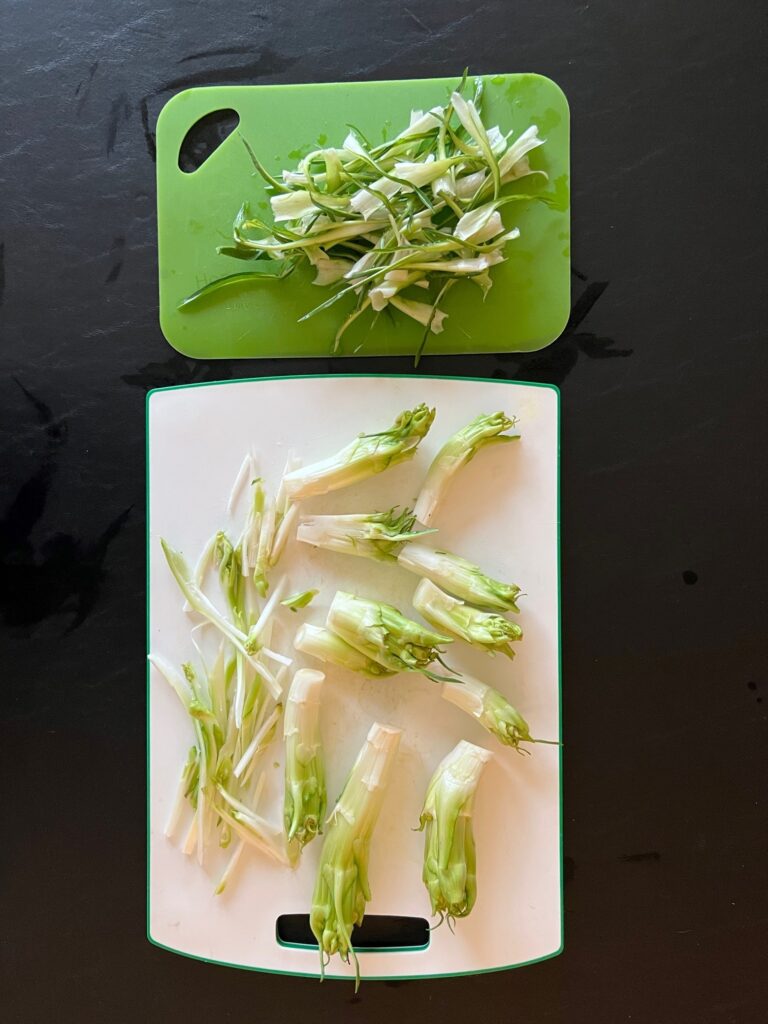
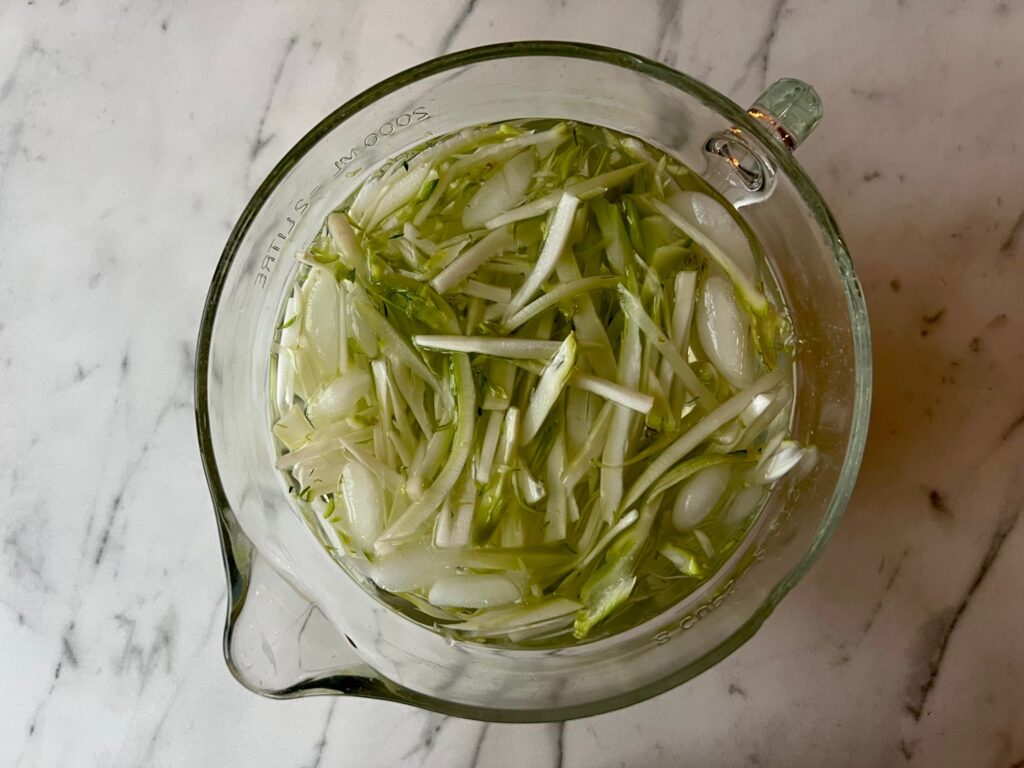
To use, drain and dry half of the puntarella strips (save the remaining half for another salad) in a clean towel. Tear or slice the radicchio crosswise into bite-sized pieces. Set aside while you make the dressing.
For a sharper garlic flavor, use it raw. Mash the garlic and anchovy with a pinch of salt in a mortar and pestle, then add the vinegar and olive oil. I mellow the garlic by warming it in a skillet: Heat a small skillet over low heat with 1 tablespoon of the olive oil, the garlic, anchovy, and a pinch of salt; with the back of a fork, mash the anchovy with the garlic to a paste – this should take just a few seconds – remove from heat. Cool slightly while you put your greens in a bowl.
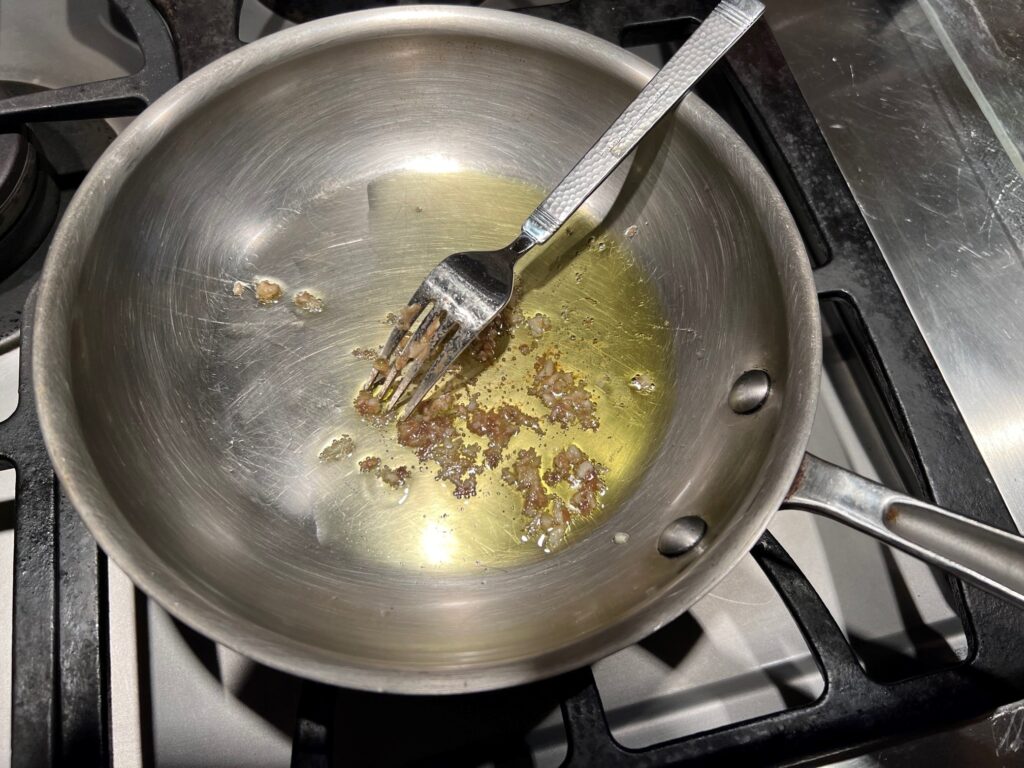
Stir vinegar, a little more salt and ground pepper into the dressing. Add the remaining 2 tablespoons of olive oil. Drizzle over the salad and toss to blend. You can add a pinch of coarse salt if you like, such as fleur de sel.
Plate and enjoy.
References
- International Food Information Council. 2021 Food & Health Survey. May 19, 2021.
- Adults Meeting Fruit and Vegetable Intake Recommendations — United States, 2019. Weekly / January 7, 2022 / 71(1);1–9. Seung Hee Lee, PhD1; Latetia V. Moore, PhD1; Sohyun Park, PhD1; Diane M. Harris, PhD1; Heidi M. Blanck, PhD. CDC.gov.
- Dietary Guidelines for Americans, 2020-2025
- Fruit and Vegetable Intake and Mortality. Results From 2 Prospective Cohort Studies of US Men and Women and a Meta-Analysis of 26 Cohort Studies. Dong D. Wang, Yanping Li, Shilpa N. Bhupathiraju, Bernard A. Rosner, Qi Sun, Edward L. Giovannucci, Eric B. Rimm, JoAnn E. Manson, Walter C. Willett, Meir J. Stampfer, and Frank B. Hu. March 1, 2021 Circulation. 2021;143:1642–1654
- How many fruits and vegetables do we really need? September 1, 2021. Heidi Godman, Executive Editor, Harvard Health Letter.
- Chicory Week
- Umami Information Center – Seafood.
© Lorelle Del Matto 2022
 About lorelle
About lorelle
Love this recipe unfortunately I live on an island with out the same selection of produce .
Any suggestions for substitutions ?
Thank you Cheryl